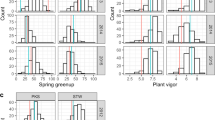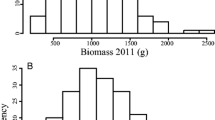Abstract
Switchgrass is a perennial C4 grass that is undergoing development as a dedicated biomass feedstock for conversion to bioenergy. Increasing biomass yield is the principal goal of most breeding programs. Delayed flowering time is one of the principal approaches toward achieving increased biomass yield. The objective of this study was to conduct and evaluate up to three cycles of phenotypic selection for altered flowering time in two populations of upland switchgrass, one tetraploid, and one octoploid. Selection was conducted in southern Wisconsin and evaluations were conducted at four locations ranging from 42 to 46° N latitude (USDA hardiness zones 4a to 5b). Realized heritability for anthesis date was high, approximately 0.7 in both populations, with selection responses averaging 5 days cycle−1. Biomass yield was strongly influenced by delayed flowering, averaging + 0.03 to 0.13 Mg ha−1 for each day delay in anthesis date. However, the biomass yield responses to delayed flowering were strongly associated with latitude of the evaluation location, decreasing by 75% as latitude increased from 42 to 46° N. There is likely a threshold latitude, above which the growing season is too short for later flowering to have a significant impact on increasing biomass yield of upland populations. Future increases in biomass yield for USDA hardiness zone 3 may be extremely difficult or impossible, or at least require different strategies.



Similar content being viewed by others
References
Association of Official Seed Analysts (1998) Rules for seed testing. AOSA, Beltsville
Bernardo R (2016) Bandwagons I, too, have known. Theor Appl Genet 129:2323–2332
Boe A, Casler MD (2005) Hierarchical analysis of switchgrass morphology. Crop Sci 45:2465–2472
Byrne SL, Conaghan P, Barth S, Arojju SK, Casler MD, Michel T, Velmurugan J, Milbourne D (2017) Using variable importance measures to identify a small set of SNPs to predict heading data in perennial ryegrass. Sci Rep 7:3566. https://doi.org/10.1038/s41598-017-03232-8
Casler MD (2005) Ecotypic variation among switchgrass populations from the northern USA. Crop Sci 45:388–398
Casler MD (2012) Switchgrass breeding, genetics, and genomics. In: Monti A (ed) Switchgrass. Springer, New York, pp 29–54
Casler MD, Vogel KP (2014) Selection for biomass yield in upland, lowland, and hybrid switchgrass. Crop Sci 54:626–636
Casler MD, Vogel KP, Taliferro CM, Wynia RL (2004) Latitudinal adaptation of switchgrass populations. Crop Sci 44:293–303
Casler MD, Vogel KP, Beal AC (2006) Registration of WS4U and WS8U switchgrass germplasms. Crop Sci 46:998–999
Casler MD, Vogel KP, Taliaferro CM, Ehlke NJ, Berdahl JD, Brummer EC, Kallenbach RL, West CP, Mitchell RB (2007) Latitudinal and longitudinal adaptation of switchgrass populations. Crop Sci 47:2249–2260
Casler MD, Vogel KP, Harrison M (2015) Switchgrass germplasm resources. Crop Sci 55:2463–2478
Casler MD, Vogel KP, Lee DK, Mitchell RB, Adler PR, Sulc RM, Johnson KD, Kallenbach RL, Boe AR, Mathison RD, Cassida KA, Min DH, Crawford J, Moore KJ (2018) 30 years of progress toward increasing biomass yield of switchgrass and big bluestem. Crop Sci 58:1242–1254
Cathey HM (1990) USDA Plant hardiness zone map. USDA Miscellaneous Publications No. 1475. U.S. National Arboretum, USDA-ARS, Washington, DC
Clifton-Brown JC, Lewandowski I (2001) Screening Miscanthus genotypes in field trials to optimize biomass yield and quality in southern Germany. Eur J Agron 16:97–110
Clifton-Brown JC, Lewandowski I, Andersson B, Basch G, Christian DG, Kjeldsen JB, Jørgensen U, Mortensen JV, Riche AB, Schwarz K, Tayebi K, Teixeira F (2001) Performance of 15 Miscanthus genotypes at five sites in Europe. Agron J 93:1013–1019
Delaquis E, Samson R, Seguin P, Mustafa A, Martel H (2014) Impacts of improved switchgrass and big bluestem selections on yield, morphological characteristics, and biomass quality. Adv Agric. https://doi.org/10.1155/2014/192824
Fu C, Sunkar R, Zhou C, Shen H, Zhang J, Matts J, Wolf J, Mann DGJ, Stewart CN, Tang Y, Wang Z (2012) Overexpression of miR156 in switchgrass (Panicum virgatum L.) results in various morphological alterations and leads to improved biomass production. Plant Biotech J 10:443–452
Grabowski PP, Evans J, Daum C, Deshpande S, Barry K, Kennedy M, Ramstein GP, Kaeppler SM, Buell CR, Jiang Y, Casler MD (2016) Genome-wide associations with flowering time in switchgrass using exome-capture sequencing data. New Phytol 213:154–169
Jensen E, Farrar K, Thomas-Jones S, Hastings A, Donnison I, Clifton-Brown J (2011) Characterization of flowering time diversity in Miscanthus species. GCB Bioenergy 3:387–400
Lee DK, Boe AR (2005) Biomass production of switchgrass in Central South Dakota. Crop Sci 45:2583–2590
Littell RC, Milliken GA, Stroup WW, Wolfinger RD (1996) SAS system for mixed models. SAS Institute, Inc, Cary
McLaughlin SB, Kzsos LA (2005) Development of switchgrass (Panicum virgatum) as a bioenergy feedstock in the United States. Biomass Bioenergy 28:515–535
McMaster GS, Wilhelm WW (1997) Growing degree-days: one equation, two interpretations. Agric Forest Meteor 87:291–300
Mullet J, Morishige D, McCormick R, Truong S, Hilley J, McKinley B, Anderson R, Olson SN, Rooney W (2014) Energy Sorghum – a genetic model for the design of C4 grass bioenergy crops. J Exp Bot 65:3479–3489
Perrin R, Vogel KP, Schmer MR, Mitchell RB (2008) Farm-scale production cost of switchgrass for biomass. Bioenerg Res 1:91–97
Price DL, Casler MD (2014) Divergent selection for secondary traits in upland tetraploid switchgrass and effects on sward biomass yield. BioEnergy Res 7:329–337
Rooney WL, Blumenthal J, Bean B, Mullet JE (2007) Designing sorghum as a dedicated bioenergy feedstock. Biofuels Bioprod Biorefin 1:147–157
Sanderson MA, Adler PR, Boateng AA, Casler MD, Sarath G (2007) Switchgrass as a biofuels feedstock in the USA. Can J Plant Sci 86:1315–1325
Schwartz C, Amasino R (2013) Nitrogen recycling and flowering time in perennial bioenergy crops. Front Plant Sci 4. https://doi.org/10.3389/fpls.2013.00076
Tornqvist C, Taylor M, Jiang Y, Evans J, Buell CR, Kaeppler SM, Casler MD (2018) Quantitative trait locus mapping for flowering time in a lowland x upland switchgrass pseudo-F2 population. Plant Genome 11. https://doi.org/10.3835/plantgenome2017.10.0093
Tsutsui W (2004) Godzilla on my mind: fifty years of the king of monsters. St Martin’s Griffin, New York
USDA-ARS (2012) USDA Plant hardiness zone map. http://planthardiness.ars.usda.gov/PHZMWEB/. Accessed 16 Sept 2019
Van Esbroeck GA, Hussey MA, Sanderson MA (1998) Selection response and developmental basis for early and late panicle emergence in Alamo switchgrass. Crop Sci 38:342–346
Vogel KP, Mitchell RB, Casler MD, Sarath G (2014) Registration of ‘Liberty’ switchgrass. J Plant Registr 8:242–247
Xu B, Sathitsuksanoh N, Tang Y, Udvardi MK, Zhang J, Shen Z, Balota M, Harich K, Zhang PY, Zhao B (2012) Overexpression of AtLOV1 in switchgrass alters plant architecture, lignin content, and flowering time. PLOS One 7:e47399
Acknowledgments
I thank Nick Baker for valuable assistance with plot establishment and maintenance and with data collection.
Funding
This research was funded by congressionally allocated funds associated with USDA Project Number 5090-21000-065-00D.
Author information
Authors and Affiliations
Corresponding author
Additional information
Publisher’s Note
Springer Nature remains neutral with regard to jurisdictional claims in published maps and institutional affiliations.
Rights and permissions
About this article
Cite this article
Casler, M.D. Selection for Flowering Time as a Mechanism to Increase Biomass Yield of Upland Switchgrass. Bioenerg. Res. 13, 100–108 (2020). https://doi.org/10.1007/s12155-019-10044-3
Published:
Issue Date:
DOI: https://doi.org/10.1007/s12155-019-10044-3




